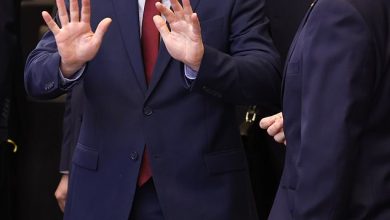Powell Signals Rate Cut Delay As Inflation Plateaus Above Target

- US Fed Chairman Jerome Powell signaled a delay in expected interest rate cuts.
- He said the Fed needs more time to be sure its fight against inflation is paying off.
- One analyst suggests excess money, the result of policies put in place during the pandemic, could be drained from the economy this year.
U.S. Federal Reserve Chairman Jerome Powell on Tuesday dampened expectations of an imminent interest rate cut – a sign that the Fed may have pumped so much money into the economy during the pandemic that the surplus continues to circulate in the country.
Speaking at a panel discussion at the Wilson Center in Washington, Powell said that while inflationary pressure has eased over the last year, it has not declined sufficiently in recent months.
“Recent data has clearly not given us greater confidence and instead indicates that it will likely take longer than expected to achieve that confidence,” Powell said Tuesday.
This means the Fed is not convinced at this point that inflation is heading toward its long-term target level of 2%.
Strong job growth is contributing to rising prices. In particular, the personal consumption expenditures price index — a key inflation measure for the Fed — was little changed in March from its February reading of 2.8%, Powell pointed out.
So the Fed can keep its interest rates higher for longer to curb rising prices – although the central bank also has room to cut if the labor market “weakens unexpectedly,” he said. added Powell.
“If higher inflation persists, we can maintain the current level of restrictions for as long as necessary,” he said.
Higher interest rates make borrowing more expensive, from mortgages to credit cards – this encourages people to save rather than spend, which, in theory, helps drive prices down. But it takes some time for the effects to be felt, and the risk is that the central bank raises rates to the point that the economy slows, or even slides into recession, as demand contracts.
Conversely, lower interest rates encourage borrowing and spending, stimulating the economy when growth slows, such as during the COVID-19 pandemic, when the Fed massively cut rates and injected money in the system.
Excess money could be drained from the economy this year, an analyst says.
Powell’s comments Tuesday contrasted with those just a month ago, when Fed officials stuck to their expectations of three rate cuts this year.
They also illustrate the Fed’s delicate balance as it attempts to steer the U.S. economy toward a “soft landing,” thereby avoiding a recession.
Jim Reid, a research strategist at Deutsche Bank, wrote in a note Tuesday that he believes it will be “incredibly difficult” to achieve a soft landing for the U.S. economy as it has gone from the strongest increase in the money supply since the World War. II at the sharpest contraction since 1930.
Even though the Fed has tightened the money supply – raising interest rates 11 times since March 2022 – the magnitude of COVID-19 stimulus and the money supply are still taking time to filter through the system, Reid added in the memo released before Powell’s comments on the same day.
But Reid thinks excess money could be drained from the economy later this year when the economy’s money supply normalizes.
“If that’s correct, then maybe cutting rates in anticipation of this is actually the right thing to do,” Reid said. “However, with inflation currently accelerating, it would be very, very difficult for the Fed to communicate and feel comfortable.”
Deutsche Bank only expects one Fed rate cut, in December 2024.
Demand, supply chain challenges and fiscal stimulus also contribute to inflation
Of course, the money supply is not the only thing that contributes to inflation.
As Bill Dudley, former chairman of the New York Federal Reserve, explained in an opinion piece for Bloomberg in February 2023, other factors influencing the U.S. economy include consumer demand and stimulus funds, and the Fed keeps rates “too low for too long.”
“If rates had been significantly higher earlier, the economy would have grown more slowly, the labor market would not be as tight, and wage and price inflation would be lower,” Dudley wrote.
Fed Chairman Powell said inflation was “transitional” amid the COVID-19 pandemic, but stopped using this term in 2022 due to persistent price increases.
The Fed will meet from April 30 to May 1 for its next policy meeting.
businessinsider




